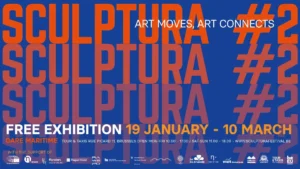Some artistic productions are a true reflection upon the nature of creating art. What defines art? Is it the theoretical discourse that accompanies the artworks, the creative process of the artist, or their approach when it comes to creation? Some artists let their works speak for themselves and create artworks that unveil the art of making art.
Most of the time, particularly when it comes to figuration, the creation of an artistic object serves the representation of a physical reality. Whether it be figures, landscapes or objects, an artwork gives something to see. In the abstract field, the artworks mode of representation is attached to an idea. The artist still put its faculty of creation to convey an intrinsic meaning. It gives something to think. The meaning or object of representation is often the reason of an artwork, and it constitutes the theoretical discourse that accompanies it.
We present you two artists sculptors whose faculty of creation, whether they aim to represent something or to convey an idea, are meant to unveil the very nature of art. The definition of what is art often involves a theoretical discourse, when sometimes some artists decide to work on art itself. More than a reflection upon creation, these artists work on the material to transform it into an artwork which theoretical reality does not define more than a simple look at it. Indeed, no need to explain these artworks, no need to understand them as a simple look is enough to size the technical background and to identify these objects as art.
« The sculptor’s intervention is a collaboration, acting in an assisting role to the manifest availabilities and possibilities…” Mattia Bosco

SW10, Mattia Bosco
Mattia Bosco is an Italian sculptor who create marble sculptures which are a synthesis between form and concept. His work starts is quarries where is finds the stones that he will later transform into pieces of art. Without theoretical expectations, the artist chooses the stones by paying attention to the complexity of their surface. He refers to this choice as a real audition. Which stone has the potential to become a work of art?
The form of the stone determines the nature of the art it is going to become. The artist only identifies the potential and decides to change the stone’s destiny by taking it back in the studio. Then, he aims only to draw out and purify the form already present in the stone by slightly sculpting it and accentuates some sections and chosen points by applying some gold leaves onto it. The results are very delicate and bear the visible transition between a rock in a quarry, and a work of art.

Hyakutake, Romain Langlois
A rehabilitation of abandoned object into art is also the idea behind Romain Langlois’s work. Very attached to this idea of rehabilitation as it questions the nature of art itself, the French sculptor uses abandoned pieces of rocks and trees as models to create limited edition sculptures. The creation process of these artwork is a transition between what is not pleasant to the eye into a work of art. This transition occurs thanks to several techniques he uses to create bronze sculptures. In contrary to Mattia Bosco’s works, Romain Langlois’ sculpture are a reproduction of what can be found in nature, but the hyperrealism of these creations makes them almost true-to-life and turn rubbish objects into piece of art.
Romain Langlois’ work – as much as Mattia Bosco’s – isn’t about reproducing nature, but to make it art.





